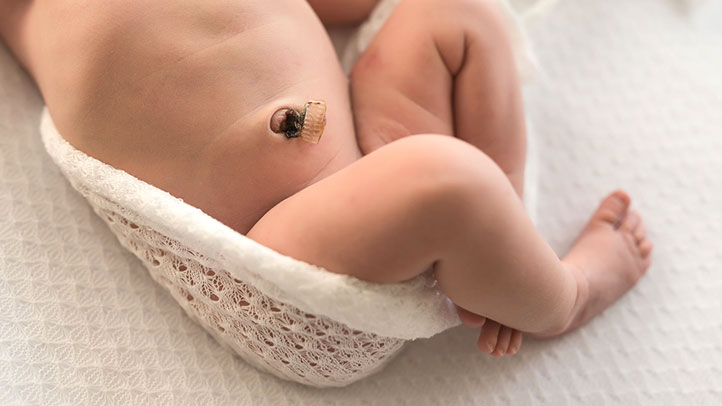Omphalitis of the newborn refers to an acute, potentially life-threatening bacterial infection of the umbilical stump. It typically manifests within the first two weeks of life and can rapidly progress to neonatal sepsis, particularly in low-resource settings or where hygiene practices during delivery and postnatal care are inadequate.
Prompt diagnosis and timely treatment are essential due to the infection’s propensity for rapid systemic spread, given the rich vascular connections at the umbilicus in neonates.

Pathophysiology and Bacterial Etiology
Omphalitis occurs when pathogens gain entry through the moist umbilical stump, particularly when proper cord care is not followed. The infection may remain localized or extend to surrounding tissues and bloodstream.
Common Causative Organisms:
- Staphylococcus aureus (most prevalent)
- Streptococcus pyogenes
- Escherichia coli
- Klebsiella species
- Anaerobic bacteria (e.g., Bacteroides)
Risk Factors:
- Home delivery without sterile techniques
- Low birth weight and prematurity
- Umbilical catheterization
- Delayed cord separation
- Poor hygiene or cultural practices involving harmful substances applied to stump
Clinical Presentation: Recognizing Symptoms of Omphalitis
Early Signs:
- Redness (erythema) around the base of the umbilicus
- Swelling and local warmth
- Purulent or foul-smelling discharge
- Delayed drying or separation of stump
Systemic Progression:
- Fever or hypothermia
- Lethargy
- Poor feeding
- Apnea or respiratory distress
- Hypotension
- Sepsis or multi-organ dysfunction
Diagnosis of Omphalitis of Newborn
Diagnosis is largely clinical, supported by laboratory investigations when systemic involvement is suspected.
Clinical Examination:
- Visual inspection of the umbilical stump and periumbilical area
- Palpation to assess tenderness, warmth, or fluctuance
Laboratory Tests:
- Complete blood count (CBC): Leukocytosis or leukopenia
- C-reactive protein (CRP): Elevated in systemic infection
- Blood cultures: To identify bacteremia
- Umbilical swab culture: For pathogen isolation and antibiotic sensitivity
- Lumbar puncture or urine cultures: If sepsis is suspected
Treatment and Management of Omphalitis
Timely and appropriate treatment is critical to prevent serious complications. Management is stratified based on the severity of the infection.
1. Hospitalization
All neonates with suspected omphalitis should be admitted for intravenous antibiotic therapy, even in the absence of systemic symptoms.
2. Empirical Antibiotic Therapy
Initiated immediately after cultures are obtained:
- First-line agents:
- Ampicillin + Gentamicin
- Cloxacillin + Cefotaxime for broader coverage
- Anaerobic coverage (e.g., Metronidazole) may be added if necrotizing infection is suspected.
Therapy is modified based on culture results.
3. Supportive Care
- IV fluids to maintain hydration
- Nutritional support, especially in preterm infants
- Monitoring for signs of sepsis or deterioration
- Surgical intervention for abscess drainage or necrotizing fasciitis, if needed
Complications of Untreated Omphalitis
If not managed promptly, omphalitis can lead to life-threatening complications, including:
- Septicemia
- Necrotizing fasciitis
- Peritonitis
- Portal vein thrombosis (pylephlebitis)
- Omphaloarteritis and omphalophlebitis
- Death, especially in settings without access to advanced neonatal care
Preventive Measures and Cord Care Practices
1. Aseptic Delivery Techniques
- Use of sterile instruments during cord clamping and cutting
- Hygienic birth practices, especially in home deliveries
2. Dry Cord Care
The World Health Organization (WHO) recommends dry cord care for healthy newborns in hospital settings:
- Keep the stump clean and dry
- Do not apply alcohol, talc, cow dung, ash, or antiseptics unless advised
3. Topical Antiseptics (in high-risk settings)
In areas with high infection risk, chlorhexidine 7.1% digluconate solution or gel may be applied daily to the stump.
4. Parental Education
- Instruct caregivers to recognize signs of infection
- Discourage harmful traditional applications
- Emphasize hand hygiene before handling the baby
Prognosis and Outcome
When diagnosed early and treated aggressively, localized omphalitis generally resolves without long-term effects. However, prognosis worsens significantly if the infection becomes systemic or if there’s a delay in initiating therapy.
Key Prognostic Factors:
- Time to treatment initiation
- Birth weight and gestational age
- Extent of infection
- Availability of advanced neonatal intensive care
Frequently Asked Questions (FAQs)
Q1: What causes omphalitis in newborns?
It is primarily caused by bacterial infection, usually introduced through improper hygiene or contaminated instruments during delivery.
Q2: How long does it take for the umbilical stump to fall off in newborns?
Typically between 5 to 15 days post-delivery. Delayed separation may indicate infection.
Q3: Is omphalitis contagious?
While not directly contagious, poor hygiene or shared contaminated objects can spread the infection to other neonates.
Q4: Can omphalitis be treated at home?
No. Omphalitis is a medical emergency and requires hospital-based intravenous antibiotics.
Q5: What is the role of chlorhexidine in cord care?
In high-risk areas, chlorhexidine helps prevent omphalitis and reduces neonatal mortality when applied to the umbilical stump.
Omphalitis of the newborn remains a preventable yet serious neonatal infection with significant mortality if overlooked. Early recognition, immediate hospital-based antibiotic treatment, and robust preventive strategies—especially in resource-limited settings—are vital to improving outcomes. Through proper education, hygienic practices, and access to essential care, the burden of neonatal omphalitis can be substantially reduced.